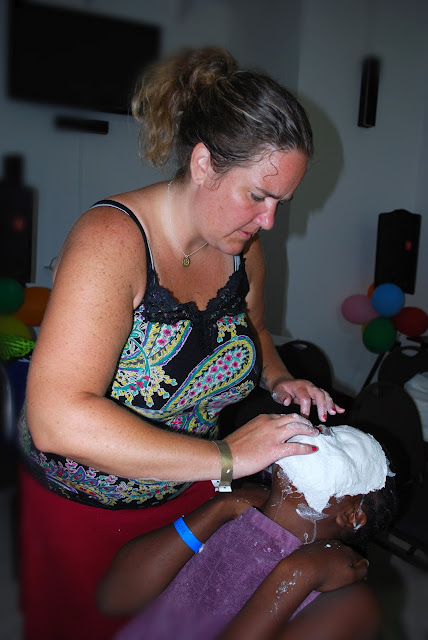 |
| Kelly showing her mask |
After helping campers create 2-dimensional life-size paintings of themselves during the first camp, I wanted to offer a 3-dimensional experience. For the second Camp Jake, I brought along plaster cast materials with which to cast each participant's face. This not only piggy-backed on the life-size paintings, but gave campers a kinesthetic experience, allowing them to discover themselves with a new media, while also playing on the symbolic nature of masks in cultures.
 |
| Samantha prepping for plaster |
 |
| Kelly working on Samantha's mask |
 |
| Skilled fingers smooth the surface |
 |
| Samantha and Kelly showing off the completed piece |
Many of our campers wore different masks returning to Camp Jake, greeting us with smiles when they got off the bus this camp; in January, however, the more common "deer in headlight" looks greeted counselors at the first camp. Returning campers were now comfortable with us and understood we were there to make them happy, to be alive, and not to fear our differences.
As people with handicap needs tend not to be treated as equals in Haiti and elsewhere in the world, it is the metaphorical mask that is worn by these campers on a daily basis when they are not in St. Vincent’s. While the Act on the Integration of Disabled People was adopted on March 13, 2012 in Haiti, it will take time and a shift in cultural norms before an act on a piece of paper changes the perspective of a people. Our campers are among a population who have been marginalized in a culture that does not understand that difference does not equate a throw away human being. Instead, differences should inspire conversation and education.
The intent of Camp Jake is to strip away the stigmas placed on the campers in their daily lives. The mask making experience allowed them to literally and figuratively display who they are in a comfortable setting. This was evident in a variety of ways during the mask making process.
Both returning and new campers were seemingly comfortable with me placing plaster on their faces, a sometimes claustrophobic or uncomfortable experience. I questioned if this was comfort or an unfortunate obligation to do what someone asks of them.
After the masks dried, each camper—blind, deaf and physically handicapped—was given the task to paint their mask on their own. Interesting conversations and experiences were revealed throughout the process.
When I asked Claurician, a camper and participant in the project, how masks are significant in Haitian culture she replied “In Haiti, masks are used in Carnival”, the biggest and most awaited celebration in the Caribbean Islands, full of colorful parades, enchanting music and traditional dances.
 |
| Caroline guiding Jesula |
 |
| Frennel examining Ulrich Jean's work-in-progress |
 | ||
Frennel being prepped for plaster
|
Samantha, a deaf teen, painted her mask with bright colors and vibrant glitter paint. The outside of her mask reflected the spirit of Samantha that was seen during the week of camp, until the last three days when she was more withdrawn with the thoughts of camp ending.
No two masks are alike which is indicative of us as human beings. In a gallery setting, an observer would have a hard time deciphering the person’s handicap needs while viewing the masks. Instead, viewers only see that each camper is another human being—one who has figuratively and now literally—worn a mask in their lifetime.
Each camper is an individual who deserves the respect and dignity to be treated as an equal to those without physical differences. In the long run, we all hold differences we wish not to be judged upon; some are just better at wearing masks than others.










No comments:
Post a Comment